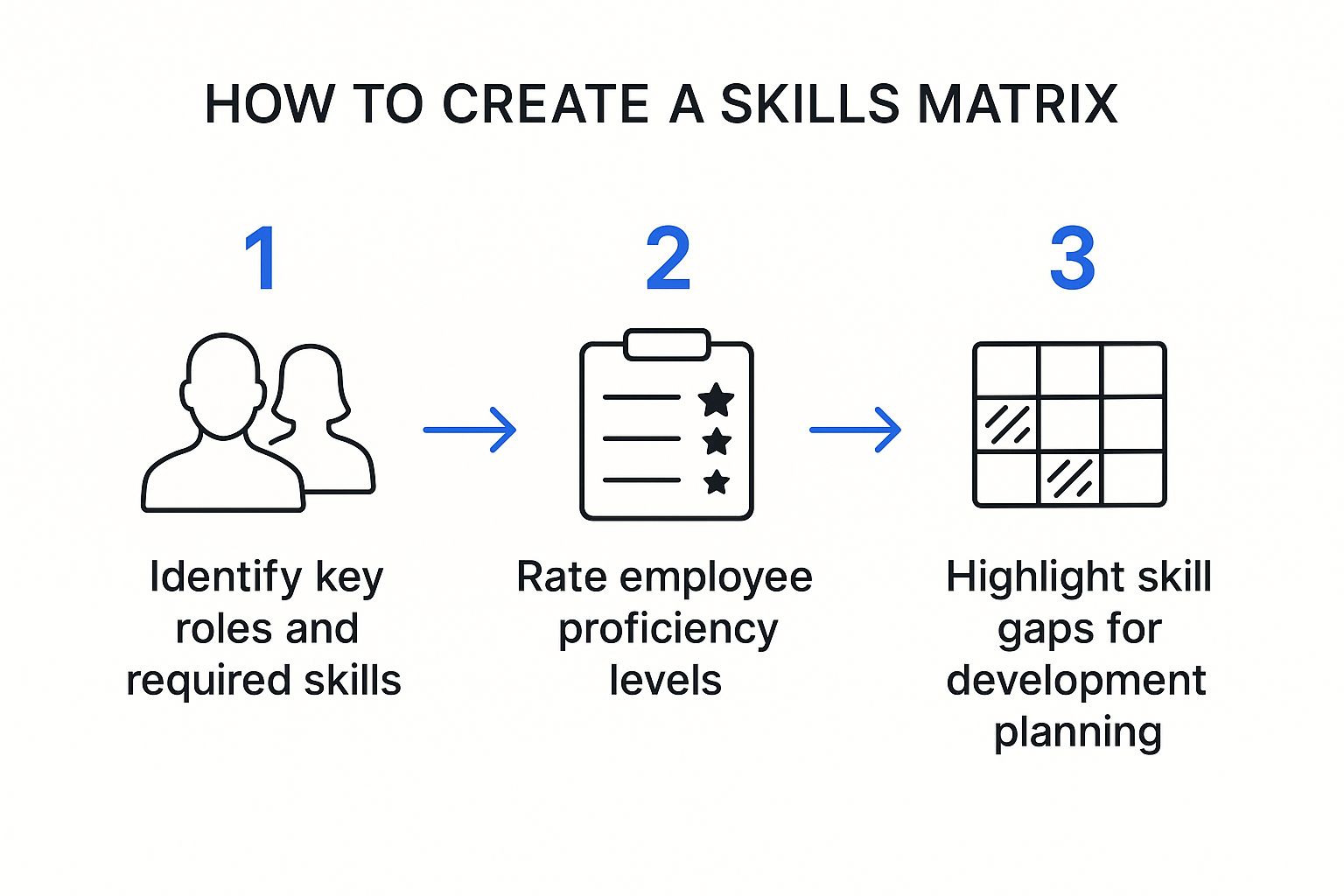At its core, a skills matrix template is a simple but powerful tool. Think of it as a grid that maps out your team's abilities. Down one side, you list your team members; across the top, you list the skills crucial for your business or a specific project. Then, you use a simple rating system to mark each person's proficiency.
The result? You can see, at a glance, exactly who knows what. This clear, visual overview is invaluable for spotting skill gaps, making smart decisions about training, and allocating the right people to the right tasks.
Why a Skills Matrix Is Your Secret Weapon

Before you jump into creating your own, it's worth understanding why a skills matrix is so much more than just another spreadsheet. It's a strategic tool that shifts your workforce planning from being reactive and based on guesswork to something proactive and driven by real data.
Instead of just hoping you have the right person for an upcoming project, you get an objective snapshot of your team’s collective strengths and weaknesses. It's this visual clarity that makes it so effective. You might instantly spot a junior developer with an advanced (but unused) talent for data visualisation, or flag a critical knowledge gap before it becomes a major problem down the line.
To get the most out of your matrix, it’s important to include the right building blocks. Here’s a breakdown of what a genuinely useful skills matrix should contain.
Core Components of an Effective Skills Matrix
This table outlines the essential elements every skills matrix should contain to be functional and insightful.
With these components in place, your matrix becomes a living document that gives you a much richer understanding of your team's potential.
Uncovering Gaps and Opportunities
A well-maintained matrix is brilliant at highlighting two common but critical issues: skill under-utilisation and skill overload. The first happens when someone's valuable abilities aren't being put to good use, which can easily lead to boredom and disengagement. The second is when a team member is constantly given tasks beyond their current skill level, risking burnout and poor-quality work. A skills matrix helps you find that productive middle ground.
This is particularly relevant in the UK’s dynamic job market. With technology moving so quickly, a staggering 93% of UK firms now admit they have an IT skills gap. A skills matrix is one of the most direct ways to map and tackle these shortfalls, creating clear pathways for employee training and development.
From Data to Decisions
Ultimately, this whole exercise is about making better, more informed decisions. A good skills matrix gives you the power to:
- Build Resilient Teams: Quickly spot and fix "single points of failure" where critical knowledge sits with just one person.
- Target Your Training Budget: Spend your learning and development funds where they will have the biggest impact on your team and business goals.
- Improve Project Outcomes: Assemble teams with a balanced mix of proven expertise and opportunities for growth.
A skills matrix transforms abstract feelings about team capabilities into concrete data. It’s the difference between saying, "I think we need more developers," and knowing, "We have a specific deficit in Python skills for our upcoming AI project."
Of course, a skills matrix is just one tool for improving how your team works together. For broader insights, especially when using collaborative platforms, resources like this article on Notion for Teams Best Practices for Enhancing Teamwork and Streamlining Projects can offer some excellent, practical advice.
How to Build Your First Skills Matrix
Building your first skills matrix can feel like a massive undertaking, but it doesn't have to be. At its core, you're just creating a simple grid to get a clear picture of your team's strengths. The real goal is to stop guessing about your team's capabilities and start using a concrete, visual tool to make smarter decisions. Think of it as creating a single source of truth for all the talent you have on board.
The first practical move is to pin down the skills that actually matter for your team. It's so easy to fall into the trap of listing every skill imaginable, but that just creates noise. Instead, laser-focus on the core competencies—both the technical stuff and the soft skills—that are absolutely critical for your team to succeed right now and in the near future. Look at your current projects, consider your upcoming business goals, and think about the specific roles people play.
Identifying and Categorising Skills
A great way to get started is to simply brainstorm with your team. I've found this collaborative approach works wonders. Not only does it make sure you don't miss anything crucial, but it also gets everyone invested from the very beginning. Just be sure to frame it as a professional development exercise, not a scary performance review.
Once you have a list, you'll want to organise the skills into logical groups to keep the matrix clean and easy to scan. Some common categories I've seen work well are:
- Technical Skills: These are the specific, teachable abilities like "Python Programming," "Advanced Excel," or "Google Analytics."
- Soft Skills: This covers the essential interpersonal stuff like "Client Communication," "Problem-Solving," or "Team Collaboration."
- Leadership Skills: If you're assessing managers or team leads, you'll need competencies like "Mentoring Junior Staff" or "Project Delegation."
Establishing a Clear Rating Scale
With your skill list sorted, you need a consistent way to measure how proficient everyone is. A simple, intuitive rating scale is your best friend here. If you make it too complex, you'll end up with confusing and inconsistent ratings, which defeats the whole purpose of the exercise.
A numerical scale from 0 to 4 is a popular and effective method, as long as you provide clear descriptions for each level. Here's a common example:
- 0 - No Knowledge: The person has zero experience or understanding of the skill.
- 1 - Basic Awareness: Has a fundamental grasp but needs quite a bit of guidance to apply it.
- 2 - Intermediate: Can get the job done independently but might need a hand with more complex problems.
- 3 - Advanced: Is highly proficient and can comfortably coach others.
- 4 - Expert: Is a go-to authority on the subject who can innovate and train the entire team.
The real secret is consistency. Whatever scale you choose, make sure everyone—from managers to individual team members—knows exactly what each rating means. This shared understanding is what makes the matrix a truly reliable tool.
This whole process of identifying skills and rating them is the foundation of everything. This infographic gives a nice, simple visual of how it all flows together.

As you can see, the process moves logically from figuring out what you need, to rating the skills, and finally, to analysing the results to plan for training and development. In fact, your skills matrix is a powerful gap analysis template in its own right, giving you a systematic way to spot and close any skills gaps in your team.
Once you have this framework in place—your employees on one axis, the critical skills on the other, and a clear rating scale—you're ready to start gathering the data. This is where your template transforms into a living, breathing resource for managing talent strategically. If you want to dive deeper into this specific part of the process, our guide on creating a https://www.beyondhire.co/blog/skills-gap-analysis-template is a great next step.
Making Your Skills Matrix Work for Your Industry

A blank skills matrix template is a great place to start, but its true value shines when you mould it to your specific industry. Let's be honest, every sector has its own world of essential skills, professional standards, and sometimes, a mountain of regulations. When you adapt your matrix to fit that reality, it stops being just a spreadsheet and becomes a powerful tool for planning your workforce and guiding careers.
Think about it. A tech start-up's matrix is going to be packed with programming languages, cloud platforms, and Agile frameworks. A financial services firm, on the other hand, will be far more focused on things like risk management, regulatory compliance, and fluency in specific accounting software. The bones of the template stay the same, but the skills you track become deeply tied to what makes your business tick.
This isn't just about listing technical skills; it's about capturing the whole picture of what success looks like in your field.
Tailoring for Regulated Sectors
When you're working in a highly regulated industry like healthcare or finance, a skills matrix takes on another layer of importance. It has to cover more than just job functions—it needs to include compliance skills as core, non-negotiable items. In essence, you’re building a framework that proves both competence and accountability.
A healthcare matrix, for example, must track skills related to:
- Clinical Governance: A real understanding of and adherence to patient care standards.
- Patient Confidentiality: Proven knowledge of data protection laws like GDPR.
- Specialised Medical Procedures: Certifications and hands-on experience with specific equipment or treatments.
This turns your matrix from a simple talent management tool into a vital risk mitigation document. It provides clear evidence that your team meets all the legal and professional benchmarks required to do their jobs safely and effectively.
The aim is to build a matrix that reflects the day-to-day realities of the role. It should be a living document that captures not only what an employee can do, but what they are certified and authorised to do within their professional scope.
A perfect real-world example of this is the Employability Skills Matrix used in the UK's health sector. First created back in 2008, it was heavily revised following major healthcare reviews to better reflect the values and behaviours expected of modern healthcare professionals. This kind of ongoing refinement, based on deep workforce analysis, is a masterclass in how a skills matrix template can evolve to support career progression in a critical UK sector. You can see how industry needs have shaped this template over time by visiting Skills for Health.
Weaving in Soft Skills and Leadership Qualities
Beyond the technical stuff and the red tape, every industry has its own prized set of soft skills and leadership traits. Your matrix needs to make room for these, because they are often what separates a good employee from a truly great one.
A creative agency, for instance, might prioritise skills like “Creative Brainstorming,” “Client Pitching,” and giving “Constructive Feedback.” A logistics company would probably lean more towards “Problem-Solving Under Pressure,” “Supply Chain Optimisation,” and “Vendor Negotiation.”
By customising every part of your skills matrix template to your industry's unique environment, you build a much sharper, more relevant tool. It becomes a precision instrument for spotting talent, planning development, and assembling a team that’s perfectly equipped to tackle the challenges and grab the opportunities in your sector. This is how a simple template becomes a cornerstone of your business strategy.
Right, you've filled out your skills matrix. That's a solid start, but the real work begins now. A spreadsheet full of data is just that—data. Its true power is unlocked when you use it to make smart decisions that genuinely strengthen your team.
This is the point where you shift from simply gathering information to actively shaping your workforce. You’re moving beyond individual ratings to get a bird's-eye view of your entire team's capability. It’s here that you’ll spot the vulnerabilities and hidden talents that day-to-day work often obscures.
From Insights to Initiatives
Once you step back and look at the completed matrix, a few common patterns will likely jump out at you. The most glaring are often the team-wide skill gaps—those crucial abilities where everyone is either a novice or completely untrained. These are your low-hanging fruit; they can often be tackled with a well-aimed group workshop or a targeted training programme.
But there’s a more dangerous, and often overlooked, issue: the single point of failure. This is where one critical skill lies solely with one person. What happens if they’re off sick, on holiday, or, worse, hand in their notice? Everything grinds to a halt. Your skills matrix shines a harsh light on these dependencies, giving you the nudge you need to start cross-training before it becomes a crisis.
A skills matrix turns a vague feeling into hard evidence. It’s the difference between thinking, "I feel like we're a bit weak on data analysis," and knowing, "Only one person on this team can handle advanced SQL, and that's a massive risk to the project."
This data-backed approach is essential, especially for high-demand skills. For instance, a recent UK government report found that businesses are scrambling to fill up to 234,000 roles that need hard data skills. With nearly half of companies admitting they can't find the right people, mapping your internal talent becomes a strategic advantage. You can dig deeper into these findings and understand the national data skills gap here.
Building Strategic Development Plans
With these insights in hand, you can build development plans that actually mean something. The trick is to prioritise effectively.
- Urgent Gaps: Tackle the single points of failure and team-wide gaps first. These are the ones actively threatening your current projects and day-to-day operations.
- Future Needs: Cast an eye toward the future. What skills will you need for that big project in six months? Or for the strategic pivot the company is planning? Start building those competencies now, so you’re not caught flat-footed.
- Individual Aspirations: Don't forget that "interest" column. When someone is genuinely keen to learn a new skill, they're already halfway there. Supporting their passion is a fantastic way to boost their engagement while plugging a gap.
This kind of structured analysis also makes your hiring process much sharper. When you know exactly what’s missing, you can write far better job descriptions and ask much more pointed interview questions. To complement your matrix, it’s worth exploring some of the best talent assessment tools for remote teams to get a more complete view of a candidate’s expertise.
Ultimately, putting your skills matrix into action is about using it as a living, breathing guide. It’s your roadmap for deciding whether to train from within, hire from outside, or reorganise your teams to create a more resilient and capable workforce.
Common Mistakes to Avoid When Using a Matrix

Rolling out a skills matrix template feels like a brilliant move for any manager. But I've seen a few common missteps turn a great idea into just another spreadsheet nobody uses. The biggest pitfall? Making it way too complicated.
It’s tempting to try and capture every single skill imaginable. The result is an overloaded grid that’s a pain to fill out and even worse to maintain. Before you know it, everyone dreads updating it.
My advice is to stick to the core competencies that truly matter for your team's success. Keep the rating scale simple and clear. A confusing system with too many levels just leads to inconsistent ratings, which defeats the whole purpose.
Another classic error is treating the matrix as a one-off project. It's not a static document you create and file away. Think of it as a living snapshot of your team's collective talent. If you don't revisit it regularly, it becomes outdated and useless surprisingly fast.
Positioning the Matrix for Success
How you introduce the skills matrix to your team is just as crucial as the matrix itself. If your team thinks it’s a secret performance review tool or a new way to micromanage them, you’ve lost before you’ve even started. They'll be defensive and you won't get honest self-assessments.
The key is to frame the skills matrix as a collaborative tool for professional development. It’s about identifying growth opportunities and celebrating strengths, not highlighting weaknesses for criticism.
Get your team involved right from the start. Explain the "why" behind it, focusing on transparency and growth. This approach is essential, especially when you’re looking at softer skills like teamwork and problem-solving. For more on this, our guide on communication skills assessment for teams has some great insights.
Keeping Your Matrix Relevant and Actionable
To avoid the "set it and forget it" trap, you need to build the matrix into your team's existing routines. A quarterly review is a great cadence for most teams. It aligns with business cycles and gives people enough time to actually work on and develop new skills.
To keep the momentum going, try these simple practices:
- Schedule Regular Updates: Don't leave it to chance. Block out dedicated time for reviews, perhaps during your one-to-ones or as part of formal development conversations.
- Integrate with Goals: Connect the skills in the matrix to real-world individual and team objectives. If an upcoming project needs stronger data analysis skills, make that a clear development goal for someone.
- Use Visuals: A spreadsheet full of numbers is hard to digest. Use conditional formatting to create a simple "heat map" with colours showing skill levels at a glance. It instantly shows where the strengths and gaps are across the team.
By steering clear of these common mistakes, your skills matrix template will become more than just a chart. It will be a dynamic tool that helps you plan strategically and gives your team a clear path for their own career growth.
Common Questions Answered
When you start using a skills matrix, a few practical questions always pop up. It's completely normal. Let’s walk through some of the most common ones I hear from managers, so you can get your matrix up and running smoothly and make sure it stays genuinely useful for the long haul.
How Often Should We Be Updating This Thing?
For the vast majority of teams, a quarterly review hits the mark perfectly. This cadence is frequent enough to catch new skills people have picked up and to adjust for shifting project demands, but it doesn't feel like a constant administrative burden. A matrix that's out of date is worse than no matrix at all—it can be downright misleading—so consistency really is everything.
That said, if your team is in a particularly fast-moving field, like a high-growth tech start-up or a busy creative studio, you might find that monthly check-ins make more sense. Some teams I've worked with find it easiest to update the matrix at the end of each major project or sprint.
A great tip is to weave these updates into your existing routines. Make it a standing agenda item in your regular one-to-one meetings or link it to personal development reviews. That way, it becomes a natural part of your management rhythm, not just another form to fill out.
Should I Let My Team Rate Their Own Skills?
Yes, you absolutely should. In my experience, the best and most accurate skills matrices come from a mix of self-assessment and manager review.
The first move should always be asking your team members to rate their own proficiency and, just as importantly, their interest in each skill. This simple step does more than just gather data; it encourages people to think critically about their own abilities and gives them a real sense of ownership over their development.
Once they've done their part, you, as the manager, should review their ratings. This is where the magic happens. It opens the door for a meaningful, one-to-one conversation. You can talk through any big differences in how you each see their skills and land on a final rating together.
This collaborative approach is vital for building trust. When your team sees the skills matrix as a tool you build together—not a judgment handed down from on high—it becomes a far more powerful and honest reflection of what your team can actually do.
What's the Real Difference Between a Skills Matrix and a Competency Framework?
This question comes up a lot, and it's a good one because the two are often confused. The easiest way to think about it is in terms of scope and purpose.
A skills matrix is a hands-on, tactical tool. It’s essentially a grid—usually in a spreadsheet—that maps specific skills (often technical ones) to individuals on your team. Its job is to give you a quick answer to the question, "Who here knows how to do X?" It's brilliant for day-to-day project staffing and spotting immediate training gaps.
A competency framework is much broader and more strategic. It doesn't just look at skills; it defines the behaviours, knowledge, and attitudes needed for success in various roles across the entire organisation. These competencies are often tied directly to company values and form the backbone of long-term career paths.
So, to put it simply, a skills matrix is often one small, practical piece that lives within a much larger competency framework. You use the matrix for the now, and the framework to plan for the future.

